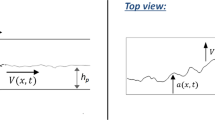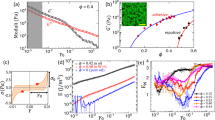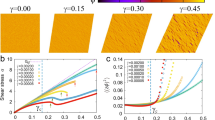Abstract
The fracture mechanism of amorphous materials, which are of crucial importance in various fields of engineering, remains a long-standing fundamental problem of science despite intensive efforts over the years. On the basis of a novel rheological model of fracture, we demonstrate that nonlinear behaviour associated with fracture is a consequence of the coupling between density fluctuations and deformation fields: shear-induced enhancement of density fluctuations is self-amplified by the resulting enhancement of dynamic and elastic asymmetry between denser and less-dense regions. This positive feedback may be the origin of fracture. We propose novel criteria for the onset of mechanical instability, extending from ductile to brittle fracture. Their validity is checked by comparing them with numerical solutions of our model and existing experimental results of metallic and polymeric glass formers. The criteria enable us to predict and design fracture behaviour of materials from the pressure dependence of their viscoelastic properties.
This is a preview of subscription content, access via your institution
Access options
Subscribe to this journal
Receive 12 print issues and online access
$259.00 per year
only $21.58 per issue
Buy this article
- Purchase on Springer Link
- Instant access to full article PDF
Prices may be subject to local taxes which are calculated during checkout





Similar content being viewed by others
References
Inoue, A. Stabilization of metallic supercooled liquid and bulk amorphous alloys. Acta Mater. 48, 279–306 (2000).
Nabarro, F. Theory of Crystal Dislocations (Oxford Univ. Press, 1967).
Spaepen, F. A microscopic mechanism for steady state inhomogeneous flow in metallic glasses. Acta Metall. 25, 407–415 (1977).
Argon, A. S. Plastic-deformation in metallic glasses. Acta Metall. 27, 47–58 (1979).
Falk, M. L. & Langer, J. S. Dynamics of viscoplastic deformation in amorphous solids. Phys. Rev. E. 57, 7192–7205 (1998).
Cohen, M. & Turnbull, D. Molecular transport in liquids and glasses. J. Chem. Phys. 31, 1164–1169 (1959).
Maeda, K. & Takeuchi, S. Atomistic process of plastic-deformation in a model amorphous metal. Phil. Mag. A. 44, 643–656 (1981).
Deng, D., Argon, A. S. & Yip, S. Simulation of plastic-deformation in a 2-dimensional atomic glass by molecular-dynamics. 4. Phil. Trans. R. Soc. 329, 613–640 (1989).
Demkowicz, M. J. & Argon, A. S. High-density liquidlike component facilitates plastic flow in a model amorphous silicon system. Phys. Rev. Lett. 93, 025505 (2004).
Shi, Y. F. & Falk, M. L. Strain localization and percolation of stable structure in amorphous solids. Phys. Rev. Lett. 95, 095502 (2005).
Varnik, F., Bocquet, L. & Barrat, L.-J. A study of the static yield stress in a binary Lennard-Jones glass. J. Chem. Phys. 120, 2788–2801 (2004).
Onuki, A. Nonlinear strain theory of plastic flow in solids. J. Phys. Condens. Matter 15, S891–S901 (2003).
Onuki, A. Plastic flow in two-dimensional solids. Phys. Rev. E. 68, 061502 (2003).
Chen, H. S. & Goldstein, M. Anomalous viscoelastic behavior of metallic glasses of Pd–Si based alloys. J. Appl. Phys. 43, 1642–1648 (1972).
Chen, H. S. Glassy metals. Rep. Prog. Phys. 43, 353–432 (1980).
Wang, W. H., Dong, C. & Shek, C. H. Bulk metallic glasses. Mater. Sci. Eng. R 44, 45–89 (2004).
Kawamura, Y., Shibata, T., Inoue, A. & Masumoto, T. Deformation behavior of Zr65Al10Ni10Cu15 glassy alloy with wide supercooled liquid region. Appl. Phys. Lett. 69, 1208–1210 (1996).
Kato, H., Kawamura, Y., Inoue, A. & Chen, H. S. Newtonian to non-Newtonian master flow curves of a bulk glass alloy Pd40Ni10Cu30P20 . Appl. Phys. Lett. 73, 3665–3667 (1998).
Lu, J., Ravichandran, G. & Johnson, W. L. Deformation behavior of the Zr41.2Ti13.8Cu12.5Ni10Be22.5 bulk metallic glass over a wide range of strain-rates and temperatures. Acta Mater. 51, 3429–3443 (2003).
Furukawa, A. & Tanaka, H. Violation of the incompressibility of liquid by simple shear flow. Nature 443, 434–438 (2006).
Bair, S. & Winer, W. O. The high pressure high shear stress rheology of liquid lubricants. J. Tribol. 114, 1–13 (1992).
Archer, L. A., Ternet, D. & Larson, R. G. ‘Fracture’ phenomena in shearing flow of viscous liquids. Rheol. Acta 36, 579–584 (1997).
Larson, R. The Structure and Rheology of Complex Fluids (Oxford Univ. Press, 1998).
Demetriou, M. D. & Johnson, W. L. Modeling the transient flow of undercooled glass-forming liquids. J. Appl. Phys. 95, 2857–2865 (2004).
Weishaupt, K., Krbecek, H., Pietralla, M., Hochheimer, H. D. & Mayr, P. Pressure dependence of the elastic constants of poly(methyl methacrylate). Polymer 36, 3267–3271 (1995).
Parry, E. & Tabor, D. Pressure dependence of the shear modulus of various polymers. J. Mater. Sci. 9, 289–292 (1974).
Li, J., Spaepen, F. & Hufnagel, T. C. Nanometre-scale defects in shear bands in a metallic glass. Phil. Mag. A 82, 2623–2630 (2002).
Liu, L. F., Dai, L. H., Bai, Y. L., Wei, B. C. & Eckert, J. Behavior of multiple shear bands in Zr-based bulk metallic glass. Mater. Chem. Phys. 93, 174–177 (2005).
Lee, J. Y. et al. Deformation and evolution of shear bands under compressive loading in bulk metallic glasses. Acta Mater. 54, 5271–5279 (2006).
Varnik, F. Structural relaxation and rheological response of a driven amorphous system. J. Chem. Phys. 125, 164514 (2006).
Varnik, F. & Henrich, O. Yield stress discontinuity in a simple glass. Phys. Rev. B 73, 174209 (2006).
Zausch, J. et al. From equilibrium to steady state: The transient dynamics of colloidal liquids under shear. J. Phys. Condens. Matter 20, 404210 (2008).
Furukawa, A., Kim, K., Saito, S. & Tanaka, H. Anisotropic cooperative structural rearrangements in sheared supercooled liquids. Phys. Rev. Lett. 102, 016001 (2009).
Tanaka, H. Viscoelastic phase separation. J. Phys. Condens. Matter 12, R207–R264 (2000).
Helfand, E. & Fredrickson, G. H. Large fluctuations in polymer solutions under shear. Phys. Rev. Lett. 62, 2468–2471 (1989).
Onuki, A. Phase transitions of fluids in shear flow. J. Phys. Condens. Matter 9, 6119–6157 (1997).
Doi, M. & Onuki, A. Dynamic coupling between stress and composition in polymer solutions and blends. J. Phys. II (Paris) 2, 1631–1656 (1992).
Onuki, A. Elastic effects in the phase transition of polymer solutions under shear flow. Phys. Rev. Lett. 62, 2472–2475 (1989).
Helfand, E. & Fredrickson, G. H. Large fluctuations in polymer solutions under shear. Phys. Rev. Lett. 62, 2468–2471 (1989).
Bruinsma, R. & Rabin, Y. Shear-flow enhancement and suppression of fluctuations in smectic liquid crystals. Phys. Rev. A 45, 994–1008 (1992).
Milner, S. T. Dynamic theory of concentration fluctuations in polymer solutions under shear. Phys. Rev. E 48, 3674–3691 (1993).
Sollich, P., Lequeux, F., Hébraud, P. & Cates, M. E. Rheology of soft glassy materials. Phys. Rev. Lett. 78, 2020–2023 (1997).
Bonn, D., Kellay, H., Prochnow, M., Ben-Djemiaa, K. & Meunier, J. Delayed fracture of an inhomogeneous soft solid. Science 280, 265–267 (1998).
Schall, P., Weitz, D. A. & Spaepen, F. Structural rearrangements that govern flow in colloidal glasses. Science 318, 1895–1899 (2007).
Moller, P. C. F., Rodts, S., Michels, M. A. J. & Bonn, D. Shear banding and yield stress in soft glassy materials. Phys. Rev. E 77, 041507 (2008).
Lewandowski, J. J. & Greer, A. L. Temperature rise at shear bands in metallic glasses. Nature Mater. 5, 15–18 (2006).
Hufnagel, T. C., El-Deiry, P. & Vinci, R. P. Development of shear band structure during deformation of a Zr57Ti5Cu20Ni8Al10 bulk metallic glass. Scr. Mater. 43, 1071–1075 (2000).
Mukai, T., Nieh, T., Kawamura, Y., Inoue, A. & Higashie, K. Effect of strain rate on compressive behavior of a Pd40Ni40P20 bulk metallic glass. Intermetallics 10, 1071–1077 (2002).
Rogallo, R. S. Numerical experiments in homogeneous turbulence, NASA Tech. Report No. NASA-TM-81315 (Ames Research Centre, 1981).
Acknowledgements
The authors are grateful to D. A. Head for a critical reading of our manuscript. This work was partially supported by a grant-in-aid for JSPS Fellows (A.F.) and a grand-in-aid from the Ministry of Education, Culture, Sports, Science and Technology, Japan (H.T.).
Author information
Authors and Affiliations
Contributions
A.F. and H.T. conceived the mechanism, A.F. carried out simulations and analysis and A.F. and H.T. wrote the manuscript.
Corresponding authors
Supplementary information
Supplementary Information
Supplementary Information (PDF 633 kb)
Rights and permissions
About this article
Cite this article
Furukawa, A., Tanaka, H. Inhomogeneous flow and fracture of glassy materials. Nature Mater 8, 601–609 (2009). https://doi.org/10.1038/nmat2468
Received:
Accepted:
Published:
Issue Date:
DOI: https://doi.org/10.1038/nmat2468
This article is cited by
-
Spatial inhomogeneity of chain orientation associated with strain-induced density fluctuations in polyethylene
Polymer Journal (2022)
-
Fatigue fracture mechanism of amorphous materials from a density-based coarse-grained model
Communications Materials (2022)
-
Effect of High-Temperature Deformation in the Supercooled Liquid Region on the Service Performance of a Zr-Based Bulk Metallic Glass
Journal of Materials Engineering and Performance (2021)
-
Nanometer-scale gradient atomic packing structure surrounding soft spots in metallic glasses
npj Computational Materials (2018)
-
Shear bands and the evolving microstructure in a drying colloidal film studied with scanning µ-SAXS
Scientific Reports (2018)



